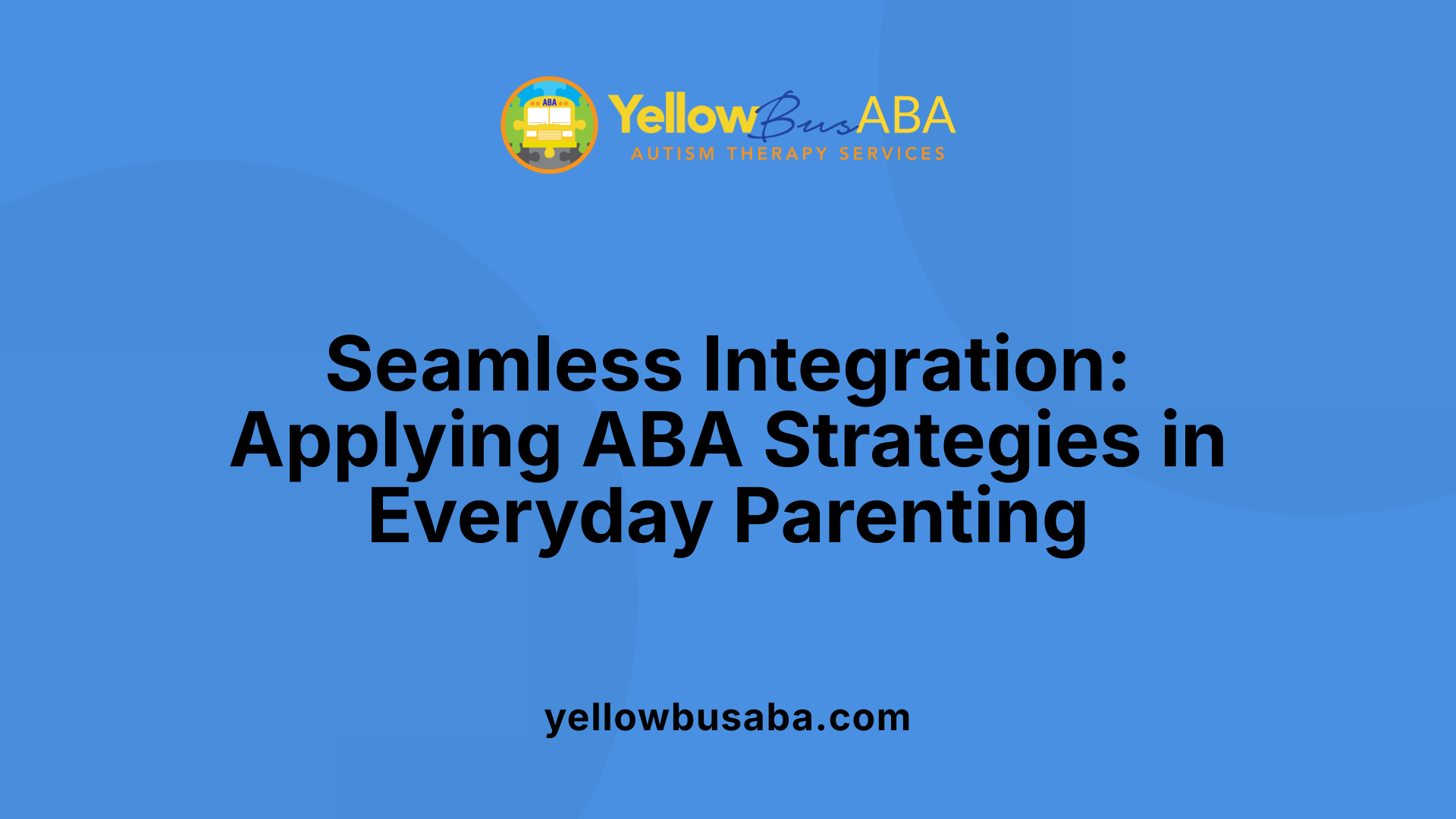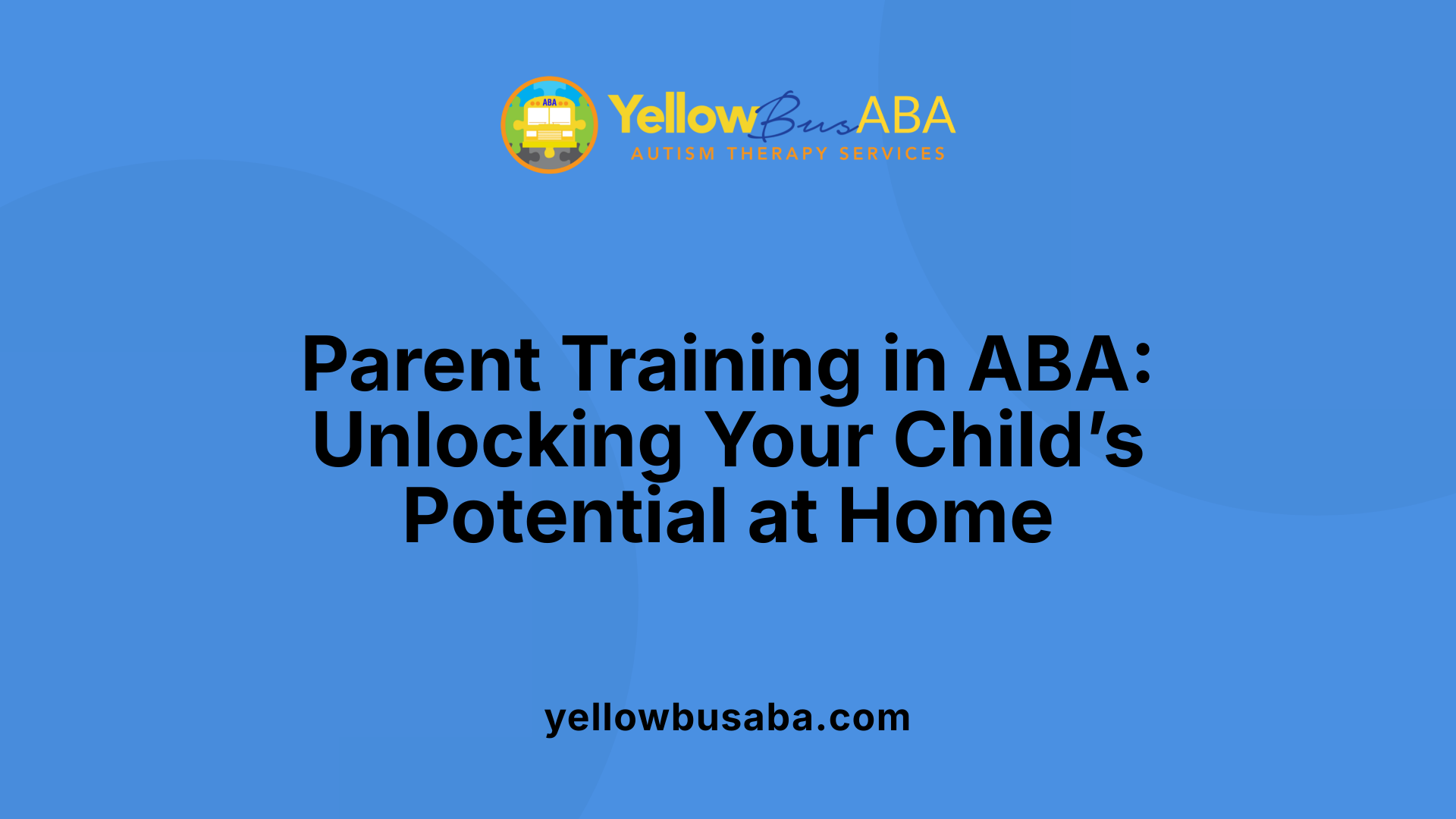Introduction to ABA in Parenting
Applied Behavior Analysis (ABA) is an evidence-based approach widely used to promote positive behaviors and skills development in children, especially those with autism spectrum disorder (ASD). While traditionally associated with clinical therapy, ABA principles are highly adaptable for everyday parenting. Integrating these strategies at home can significantly enhance a child's communication, independence, and social skills. This article explores practical ways parents can incorporate ABA techniques into daily routines to foster a supportive and developmental environment.
Applying ABA Principles Beyond Therapy Sessions

How can ABA principles be applied in daily life beyond therapy sessions?
Applied behavior analysis (ABA) techniques are highly effective when integrated into everyday routines, not just during formal therapy. Parents and caregivers can reinforce positive behaviors by offering immediate praise, treats, or preferred activities whenever children display desired behaviors, like sharing toys or completing a chore.
Modifying environmental cues helps children understand expectations more clearly. For example, using visual schedules, checklists, or visual prompts can guide children through daily routines such as getting ready for school or brushing teeth. Such supports reduce anxiety and increase independence.
Prompting, modeling, and redirection are versatile techniques that can be used at home, school, or in community settings. A parent might use a gesture to prompt a child to start a task, model the desired behavior, or redirect to a more appropriate activity, gradually fading assistance as the child learns.
Addressing antecedents—what happens before a behavior occurs—is essential for preventing challenging behaviors. Adjustments like removing triggers or providing clearer cues can create a calm environment that encourages positive responses.
Furthermore, ensuring skills are practiced consistently across various settings—home, school, and community—helps children generalize their abilities. This supports their social interaction, emotional regulation, and overall independence, leading to meaningful progress outside structured therapy.
In summary, these ABA strategies—reinforcement, environmental modifications, prompting, antecendent management, and generalization—are practical tools that foster continuous development and skill retention in everyday life, promoting a more engaging, supportive environment for children with ASD.
Fundamental Principles of Successful ABA Programs

What are the essential principles or rules that underpin successful ABA programs?
Successful ABA programs are built upon core principles that ensure interventions are meaningful, scientifically grounded, and effective in promoting lasting change. These foundational aspects are often summarized in seven dimensions: applied, behavioral, analytic, technological, conceptually systematic, effective, and generalizable.
Firstly, the applied dimension emphasizes the importance of addressing behaviors that are socially significant and meaningful to the individual's life. This means focusing on skills that improve independence, communication, and social functioning.
The behavioral aspect ensures that interventions are based on observable and measurable behaviors. By clearly defining behaviors, practitioners can track progress and adjust strategies accordingly.
Analytic components involve demonstrating a functional relationship between the intervention procedures and behavioral changes. This scientific approach guarantees that behaviors change because of specific, well-designed strategies.
The technological dimension highlights the importance of clear and detailed procedures that can be replicated consistently across different practitioners and settings. This clarity enhances reliability and fidelity in implementation.
Conceptually systematic practices refer to interventions grounded in behavioral principles and theories. They ensure that strategies are not just effective but also scientifically coherent.
Effectiveness requires that interventions produce meaningful improvements in the individual's behavior, enhancing their quality of life.
Finally, generalizability ensures that acquired skills transfer across various environments, situations, and over time, making the intervention sustainable and impactful.
In addition to these seven dimensions, integrating routine data collection and analysis allows for ongoing evaluation and customization of strategies. Reinforcement, prompting and fading, modeling, and teaching through natural activities all support these principles.
By adhering to these core components, ABA practitioners can design programs that are scientifically sound, socially valuable, and capable of producing durable changes. Consistency, clear procedures, and reliance on scientific evidence are what distinguish successful ABA interventions from less effective approaches.
For more detailed insights, exploring resources under the search term "Principles of effective ABA programs" can provide further guidance on designing and implementing these principles successfully.
Integrating ABA Into Parenting and Home Routines

How can ABA strategies be incorporated into everyday parenting and home routines?
Applied Behavior Analysis (ABA) provides practical techniques that can be seamlessly integrated into daily family life to support children with developmental needs, such as those on the autism spectrum. One effective method is establishing structured routines supplemented with visual supports like schedules and checklists. These tools help children understand what to expect, reduce anxiety, and promote independence.
Positive reinforcement plays a vital role in motivating children. During everyday activities like mealtime, bath time, or chores, parents can praise, offer preferred items, or use reward tokens to reinforce desirable behaviors. This immediate acknowledgment encourages children to repeat positive actions.
Breaking complex skills into smaller, manageable steps makes learning easier. For example, rather than expecting a child to complete a whole task at once, parents can teach each step separately. Practicing these steps through natural activities, such as cooking or shopping, creates engaging learning moments.
Consistency across routines is crucial. When everyone in the family uses similar strategies, children experience a predictable environment that fosters learning and reduces conflicting behaviors. Additionally, involving all family members and clearly explaining the reinforcement routines ensures continuous support.
Collaborating with trained professionals like Behavior Analysts and therapists helps customize strategies suited to each child's unique needs. They provide guidance on effective reinforcement, prompt fading, and behavior management, ensuring that home routines are aligned with therapy plans.
By thoughtfully applying ABA principles—such as routine organization, positive reinforcement, skill breakdown, and family collaboration—parents can create a nurturing environment. This approach not only advances skill development and social engagement but also makes daily routines smoother and more enjoyable for everyone involved.
Effective ABA Techniques Parents Can Use at Home

What are some effective ABA techniques parents can use to support their child's development at home?
Parents play a vital role in reinforcing the skills learned during therapy sessions by implementing simple yet effective ABA techniques in everyday life. One of the most foundational strategies is establishing predictable routines supported by visual aids like schedules, pictures, or symbols. These visual supports help children understand what to expect in activities like mealtime, bedtimes, and chores, reducing anxiety and promoting independence.
Positive reinforcement is another cornerstone of ABA at home. Parents can encourage desired behaviors by immediately rewarding their child with verbal praise, favorite treats, or tokens that can be exchanged for preferred activities. This consistent reinforcement motivates children to repeat positive behaviors and learn new skills effectively.
Creating a distraction-free environment further supports learning. Designating specific areas for therapy and organizing materials ensures that children are focused and receptive. Minimizing noise and distractions makes it easier to implement routines and reward systems consistently.
Collaboration with ABA professionals remains essential. Regular communication with therapists helps parents receive tailored guidance, monitor progress, and adjust strategies as needed. Professionals can also assist in teaching parents how to fade prompts and generalize skills across different settings.
Integrating these strategies into daily routines transforms ordinary activities into meaningful learning opportunities. Whether during grocery shopping, playtime, or chores, applying ABA principles helps reinforce communication, social skills, and independence, leading to meaningful and lasting developmental progress.
The Role of Parent Training in ABA Implementation

Benefits of parent training
Parent training in ABA provides families with essential tools to support their child's development effectively. By learning and practicing strategies such as positive reinforcement, visual schedules, and breaking routines into manageable steps, parents can promote independence and positive behaviors at home. Training enables caregivers to embed ABA techniques in daily activities like mealtime, bath time, and play, which reinforces learning and generalization of skills across environments.
This approach also enhances communication and social skills in children by turning everyday interactions into meaningful learning opportunities. When parents are equipped with these skills, they can systematically manage challenging behaviors, reducing frustration and fostering a supportive atmosphere that encourages progress.
Behavioral parent training techniques
Behavioral parent training involves teaching specific strategies to modify behaviors and promote positive actions. Techniques include using visual aids such as schedules and checklists to help children understand routines, offering immediate praise or treats as reinforcement for desirable behaviors, and modeling desired behaviors through demonstration.
Prompting, fading prompts gradually, and conducting role-plays strengthen skill acquisition and independence. Parents are also taught to analyze behavior data to identify patterns and adjust approaches accordingly. Consistent application of these methods, along with patience and celebration of small achievements, leads to sustained improvements.
Setting goals and monitoring progress
Effective parent training starts with setting clear, measurable goals aligned with the child's needs. These may include improving communication skills, reducing behaviors like tantrums, or increasing independence in daily routines.
Tracking progress through data collection—such as recording instances of targeted behaviors—enables parents and professionals to evaluate the effectiveness of strategies. Regular reviews and adjustments ensure that routines remain personalized and responsive to the child's evolving needs. Using Behavior Skills Training (BST) methods can help parents practice and refine interventions, leading to better outcomes.
Professional support and collaboration
Parents benefit immensely from the guidance and collaboration of trained professionals like Board Certified Behavior Analysts (BCBAs) and Registered Behavior Technicians (RBTs). These experts analyze the child's individual needs, provide training on ABA principles, and help develop tailored intervention plans.
Collaborative efforts involve coaching parents in implementing strategies, observing their application, and providing feedback. This partnership ensures consistency across therapy sessions, home routines, and school environments, maximizing the child's development. Addressing challenges such as time constraints or emotional stress is easier when parents have ongoing support.
| Aspect | Description | Supporting Strategies |
|---|---|---|
| Benefits of Parent Training | Empowers families to facilitate learning at home | Visual schedules, positive reinforcement, everyday routines |
| Techniques | Includes modeling, prompting, data tracking | Role-playing, reinforcements, gradual fading of prompts |
| Goal Setting | Establishes clear, measurable objectives | Progress monitoring, data analysis, adaptable routines |
| Professional Collaboration | Ensures trained, consistent support | Continuous coaching, feedback, tailored plans |
When parents are trained in ABA techniques, they become active participants in their child's growth journey. Routine integration of these strategies creates a consistent, nurturing environment that fosters meaningful improvements and independence in children with ASD.
Barriers and Solutions in Implementing ABA Strategies at Home
What are some common challenges in applying ABA strategies at home, and how can they be addressed?
Many parents find it challenging to consistently implement ABA techniques in everyday life. Common obstacles include maintaining routine consistency, managing limited time, and dealing with emotional stress that can arise when behavioral issues occur. These challenges can make it difficult to stick to the intervention plan and see steady progress.
To overcome these issues, parents are encouraged to develop structured routines using visual schedules or checklists. These tools provide clarity and predictability for children, reducing anxiety and making behavior management easier. Breaking down tasks into small, manageable steps can make implementation less overwhelming.
Seeking professional support is also crucial. BCBAs (Board Certified Behavior Analysts) or local support groups can offer guidance, troubleshoot problems, and help refine strategies. Involving other family members in the routines distributes responsibilities, making it easier to stay consistent.
Patience plays a vital role. Celebrating small achievements can motivate parents to continue efforts despite setbacks. Overall, establishing predictable routines, seeking help, and maintaining a patient, positive attitude are effective solutions to these common challenges.
Conclusion: Embracing ABA in Daily Parenting
What is the overall importance of incorporating ABA in daily parenting?
Integrating ABA strategies into everyday parenting plays a vital role in supporting children's growth and development, especially for those with autism spectrum disorder (ASD) or other neurodevelopmental conditions. These techniques help improve behavior, foster skill development, and promote independence. When parents use methods like positive reinforcement, visual aids, and routine structuring, they create a stable and welcoming environment that encourages learning.
Consistent application of ABA principles encourages positive social interactions and emotional regulation. It also offers parents tools to manage challenging behaviors in a constructive way, thereby enhancing the overall family dynamic. Importantly, applying ABA daily means children get continuous support across different environments, which promotes generalization of skills. This ongoing, integrated approach supports lasting developmental gains.
Continuous learning and adjustment
Effective ABA in daily parenting involves ongoing learning. Parents are encouraged to monitor progress, gather data on behaviors, and make necessary adjustments. Professional guidance from behavior analysts ensures that strategies stay aligned with the child's evolving needs. This flexibility allows families to celebrate small achievements, stay patient through setbacks, and refine routines for better outcomes.
Importance of collaboration and professional support
Working closely with trained professionals such as Board Certified Behavior Analysts (BCBAs) and Registered Behavior Technicians (RBTs) enhances the effectiveness of ABA strategies. These experts help parents understand behavioral principles, develop personalized plans, and troubleshoot challenges. Collaborative efforts between families, educators, and therapists ensure consistency across settings and reinforce learned skills.
Creating a nurturing environment
Incorporating ABA at home involves turning daily activities into engaging learning opportunities. Visual schedules, reward systems, and modeling desired behaviors make routines predictable and manageable. This structured yet flexible approach helps children feel secure and motivated to learn.
Moreover, fostering emotional warmth and patience during ABA implementation strengthens trust and encourages positive emotional development. Families that actively participate in ABA, supported by professional guidance, create nurturing environments where children thrive both socially and academically. As a result, children gain important life skills, improve communication, and develop confidence, all within a loving family setting.
Final Thoughts and Future Steps
Implementing ABA strategies in everyday parenting fosters a positive, structured environment that promotes a child's growth and independence. Consistent application, ongoing collaboration with professionals, and adapting strategies to meet individual needs are key to success. With patience and perseverance, parents can effectively support their child's development and build a foundation for lifelong skills.
References
- ABA Strategies for Parents: 5 Daily Techniques That Make a ...
- Parent Training in ABA: Turn Everyday Moments into Learning
- Easy ABA Techniques to Use with Your Child
- Behavioral Parent Training: Important Tips and Strategies | Regis
- How to Use ABA Principles in Everyday Life with Your Child
- Mastering Parent Training in ABA: A Comprehensive Guide
- ABA in Everyday Life
- How To Apply ABA Principles to Everyday Life
- Using Applied Behavior Analysis in everyday life


.avif)
.jpg)


